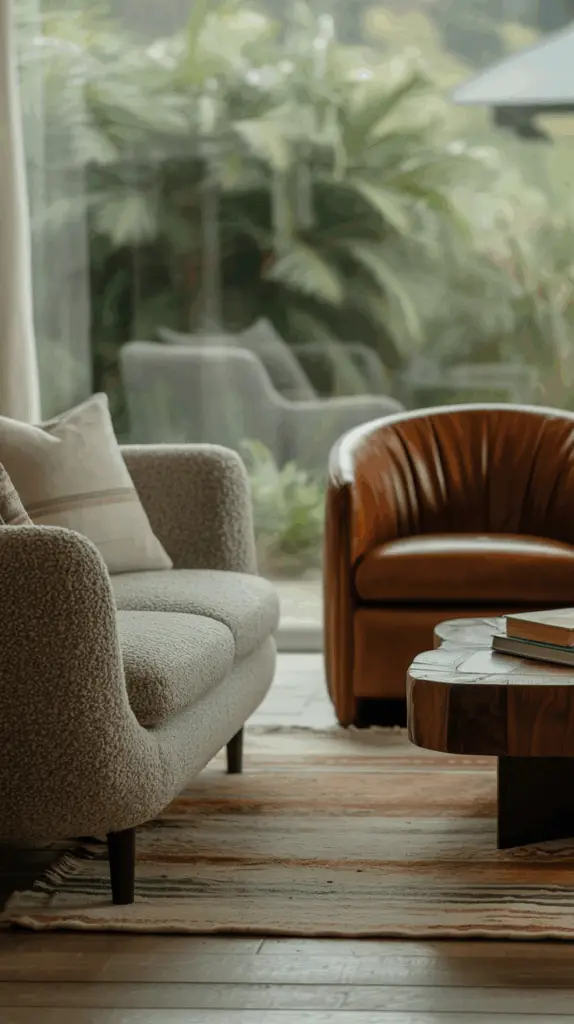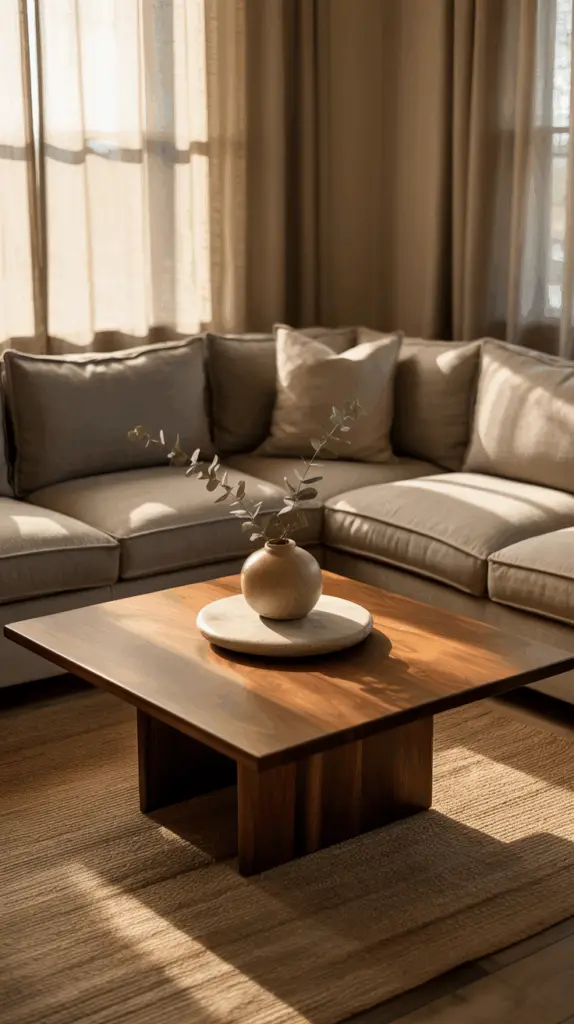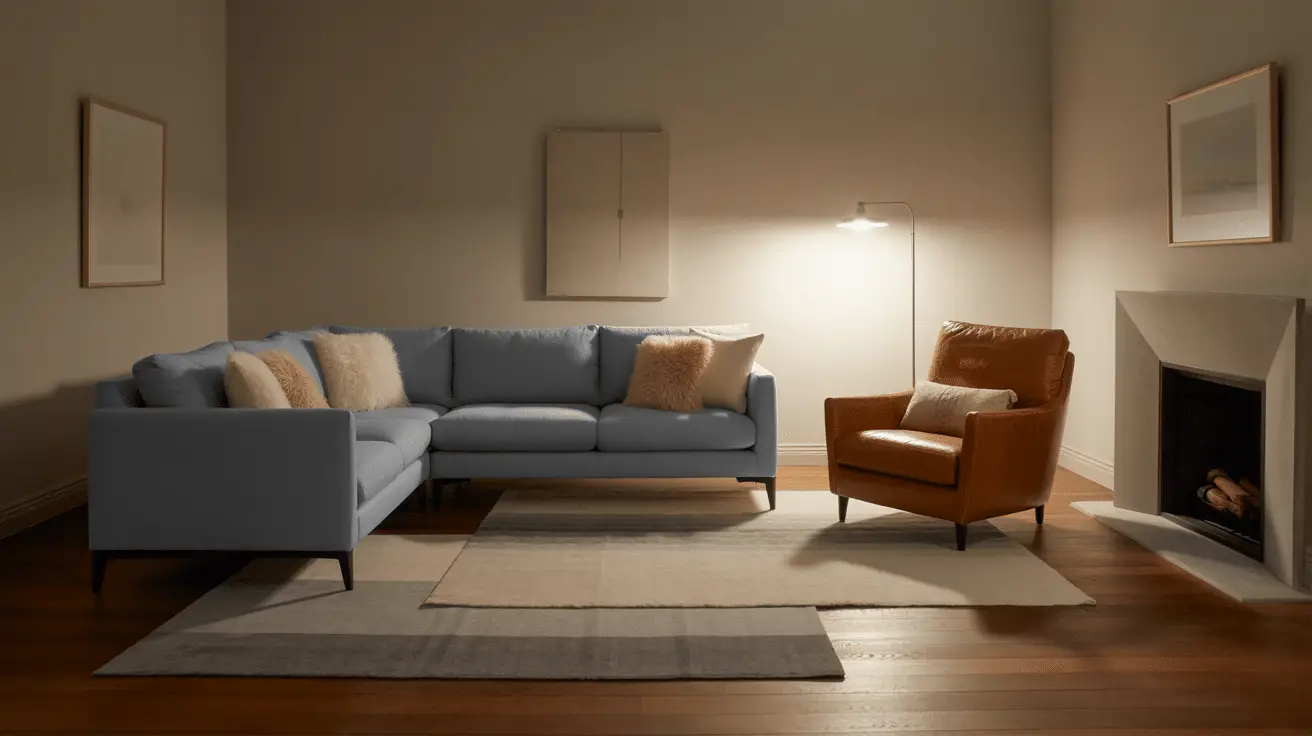How to Mix Grey and Brown Living Room Textures for a Timeless, Sophisticated Look
Table of Contents
Design trends come and go, but timeless style is always in demand. One of the most enduring and sophisticated combinations in home decor is the pairing of grey and brown. While some may shy away from mixing these two neutrals, thinking they might clash, the truth is—when layered thoughtfully, grey and brown can create a living room that feels warm, grounded, and utterly elegant.
This unexpected duo is gaining traction for good reason. According to a 2024 Houzz report, homeowners are increasingly turning toward “quiet luxury” design palettes that blend rich natural tones with textural contrasts. Grey and brown deliver exactly that: cool and warm undertones working together to create balance, depth, and visual interest.
In this article, we’ll explore how to mix grey and brown textures in your living room without sacrificing cohesion. You’ll learn how to choose complementary tones, layer textures for dimension, integrate wood, leather, and fabric pieces seamlessly, and style accent elements that bring the entire palette to life. Whether you’re designing from scratch or updating an existing room, this guide will help you create a space that feels elevated yet inviting.
Understand the Balance of Cool and Warm Neutrals
To successfully mix grey and brown in your living room, you first need to understand their tonal qualities. Grey is typically seen as a cool, calm color, while brown brings warmth and earthiness. The magic happens when you create balance—pairing the right undertones so that the combination feels intentional rather than mismatched.
Start by identifying the undertones of your chosen shades. Warm greys (those with hints of taupe or beige) work beautifully with medium to dark browns. Likewise, cooler greys pair well with lighter, sandy-toned browns or weathered wood finishes. Avoid mixing harsh, cold greys with overly red or orange browns—they can feel disconnected.
An effective strategy is to use grey as your dominant background (walls, sofa, large rugs), then add brown as a grounding accent (wood furniture, leather chairs, natural fiber elements). This keeps the space feeling light and modern while adding warmth through organic materials.
Grey & Brown Undertone Pairing Guide
| Grey Shade | Best Brown Companion | Design Effect |
| Cool Charcoal Grey | Pale Oak or Driftwood Brown | Modern and airy |
| Warm Greige | Espresso or Walnut Brown | Elegant and rich |
| Light Silver Grey | Camel or Cognac Leather | Balanced and contemporary |
| Steel Blue-Grey | Warm Chestnut | Moody and layered |
Layer Textures for Depth and Dimension
Texture is the secret ingredient that elevates a neutral color palette from flat to dynamic. When mixing grey and brown, texture becomes essential to add warmth, contrast, and visual rhythm to the room.
Start with foundational layers. A soft grey area rug in wool or jute grounds the space and can be layered with a brown cowhide or woven rug for extra depth. Upholstery should vary too—think boucle or tweed in grey for sofas, and smooth leather or distressed wood for brown-toned accents.
Incorporate at least three distinct textures in each color family. For instance, pair a grey velvet throw with a chunky knit pillow and linen drapes. On the brown side, mix leather, wicker, and warm wood finishes. These tactile contrasts prevent the palette from feeling too uniform and create a sense of richness and balance.
Finishing touches like metallics, glass, or stone can also be layered in without disrupting the neutral harmony. Bronze or matte black fixtures add a subtle contrast and complete the look.
Texture Layering Inspiration Table
| Texture Type | Grey Element Example | Brown Element Example |
| Upholstery | Linen sofa, boucle ottoman | Leather accent chair |
| Rug/Flooring | Soft grey wool rug | Natural jute or cowhide overlay |
| Hard Surface | Greywashed coffee table | Reclaimed oak sideboard |
| Accent Accessories | Knit throw, ceramic vase | Woven basket, wooden trays |

Choose the Right Wood Tones to Warm Up Grey Palettes
Wood is one of the most natural and effective ways to introduce brown into a grey-toned space. But not all wood tones work equally well. The key is selecting finishes that feel cohesive with the mood and undertones of your room.
Light, weathered woods like white oak or ash create a soft, Scandinavian feel when paired with pale greys. For richer or more traditional aesthetics, medium-tone walnuts or cherry woods offer beautiful contrast. Dark woods like espresso or mahogany should be used sparingly in grey rooms to prevent the space from feeling too heavy unless you’re aiming for a moody or masculine look.
Incorporate wood through coffee tables, console units, shelving, and decorative elements like frames or bowls. Don’t forget the floor—wood or wood-look floors in warm tones provide a perfect foundation to offset cooler greys on walls or furniture.
When blending multiple woods, aim to vary the tone but keep the grain consistent (or vice versa) to create intentionality rather than chaos.
Wood Tone & Grey Palette Coordination Table
| Wood Finish | Best Grey Companion | Design Mood |
| Whitewashed Oak | Light Silver or Mist Grey | Scandinavian, airy |
| Walnut or Teak | Warm Greige or Dove Grey | Mid-century modern, organic |
| Weathered Driftwood | Cool Stone Grey | Coastal, rustic |
| Espresso or Mahogany | Charcoal or Slate Grey | Formal, traditional |

Integrate Leather for Timeless Warmth
Leather is a classic material that bridges the gap between grey and brown effortlessly. Its rich, natural finish adds warmth and contrast to cooler grey tones, making it a perfect choice for furniture and accents in mixed-neutral spaces.
One of the most popular and effective ways to do this is by adding a brown leather armchair or ottoman to a grey sofa arrangement. Cognac, camel, and saddle-toned leathers offer the most versatility. These shades contrast beautifully with both light and dark greys while still feeling cohesive and natural.
If you’re hesitant about full leather pieces, start small. Leather drawer pulls, woven leather trays, or vintage leather-bound books can add subtle warmth without committing to large-scale items.
Don’t forget texture again here—smooth, glossy leathers feel sleek and formal, while distressed or matte finishes give off a cozy, lived-in vibe. Combining leather with soft grey textiles such as wool or linen creates a visually and physically inviting setting.
Leather Accents That Enhance Grey Living Rooms
| Leather Accent | Suggested Pairing | Overall Effect |
| Camel Leather Chair | Soft grey couch, ivory rug | Warm and modern |
| Distressed Ottoman | Cool grey sectional, oak floor | Rustic and inviting |
| Leather-Wrapped Tray | Grey coffee table | Subtle richness |
| Saddle Leather Pouf | Stone grey wall, wood shelf | Boho meets industrial |
Incorporate Earthy Decor and Natural Materials
Natural materials enhance the grey and brown color story by grounding the room in organic simplicity. Think woven fibers, ceramics, clay, stone, and aged metal finishes. These elements reinforce the timeless quality of your design without competing for attention.
Rattan, jute, and seagrass are especially effective when used as rugs, baskets, or lampshades. They introduce tactile variety while tying the brown elements together. Ceramic vases in soft greys or sand tones can sit on shelves or tables, adding sculptural interest.
Stone—especially in the form of slate, travertine, or soapstone—adds another layer of texture. Whether it’s a tabletop, candle holder, or tiled fireplace surround, it works beautifully with both grey and brown color palettes.
Even small additions like clay planters, linen curtains, or wooden beads can subtly emphasize the harmony of natural tones in the room.
Organic Material Styling Suggestions
| Material | Decor Piece Example | Placement Idea |
| Jute | Rug, planter basket | Under coffee table or side chair |
| Ceramic | Vase, bowl, lamp base | Shelf, console, or tabletop |
| Rattan | Pendant light, storage basket | Ceiling feature or under console |
| Stone | Slate tray, marble bookends | Coffee table or mantel |
Add Grey and Brown Through Thoughtful Accessories
Accessories are the finishing touches that bring harmony to your grey and brown living room. They help reinforce your palette while offering flexibility to refresh your space over time.
Start with textiles—cushions, throws, and curtains are an easy way to introduce additional tones and patterns. For example, pair a grey sofa with brown and beige patterned pillows, or mix solid neutrals with herringbone and checks for subtle variety.
Wall art is another opportunity to echo your palette. Look for prints in sepia tones, greyscale photography, or abstract canvases with hints of wood grain and stone colors.
Mix metals thoughtfully. Warm metals like brass and bronze pair well with brown elements, while brushed nickel and pewter complement grey. You can blend both in a room as long as they appear in multiple places and with intention.
Finally, balance your accessorizing. Not every surface needs to be filled—negative space helps the layered textures and materials breathe.
Living Room Accessory Guide for Grey + Brown Palettes
| Accessory Type | Neutral Color Suggestions | Placement Tips |
| Throw Pillows | Grey, beige, taupe, rust | Mix solids and patterns |
| Curtains | Light grey linen or flax brown | Floor length for elegance |
| Tabletop Decor | Stoneware, antique books | Group in odd numbers for impact |
| Wall Art | Abstract, muted landscape | Stick to 2–3 main tones |
Conclusion
Blending grey and brown textures in your living room creates a timeless, layered, and harmonious space that feels both sophisticated and cozy. When thoughtfully combined through the use of undertones, materials, and accessories, this neutral duo becomes a canvas for any style—from rustic to modern, traditional to minimalist.
By understanding how these tones interact, incorporating textural variety, and choosing finishes that feel organic and intentional, you can design a living room that not only looks beautiful but also feels welcoming every day. Ultimately, grey and brown are more than just colors—they’re an invitation to create depth, comfort, and elegance in your most lived-in space.

